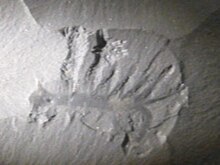Hallucigenia
|
Hallucigenia Temporal range: Cambrian Stage 3–Middle Cambrian |
|
|---|---|
 |
|
| Fossil of Hallucigenia from the Burgess shale | |
| Scientific classification | |
| Kingdom: | Animalia |
| Stem group: | Onychophora |
| Clade: | †Hallucishaniids |
| Family: | †Hallucigeniidae |
| Genus: |
†Hallucigenia Conway Morris, 1977 |
| Species | |
|
|
| Synonyms | |
|
Canadia sparsa |
|
Canadia sparsa
Hallucigenia is a genus of Cambrian xenusiids known from articulated fossils in Burgess Shale-type deposits in Canada and China, and from isolated spines around the world. Its quirky name reflects its unusual appearance and eccentric history of study; when it was erected as a genus, the animal was reconstructed upside down and back to front. Hallucigenia is now recognized as a "lobopodian worm". It is considered by some to represent an early ancestor of the living velvet worms, although other researchers favour a relationship closer to arthropods.
Hallucigenia is a 0.5—3.5 cm long tubular organism with seven or eight pairs of slender legs, each terminating with a pair of claws. Above each leg is a rigid conical spine. The 'head' and 'tail' end of the organism are difficult to identify; one end extends some distance beyond the legs and often droops down as if to reach the substrate. Although some specimens display traces of a gut, the internal anatomy has not been formally described. Recent research suggests that the extended element is an elongated head with two simple eyes, a mouth with radial teeth, and pharyngeal teeth within the front of the gut.
Hallucigenia's spines are made up of one to four nested elements. Their surface is covered in an ornament of minute triangular 'scales'.
Hallucigenia was originally described by Walcott as a species of the polychaete worm Canadia. In his 1977 redescription of the organism, Simon Conway Morris recognized the animal as something quite distinct, establishing the new genus. No specimen was available that showed both rows of legs, and as such Conway Morris reconstructed the animal walking on its spines, with its single row of legs interpreted as tentacles on the animal's back. A dark stain at one end of the animal was interpreted as a featureless head. Only the forward tentacles could easily reach to the 'head', meaning that a mouth on the head would have to be fed by passing food along the line of tentacles. Conway Morris suggested that a hollow tube within each of the tentacles might be a mouth. This raised questions, such as how it would walk on the stiff legs, but it was accepted as the best available interpretation.
...
Wikipedia
